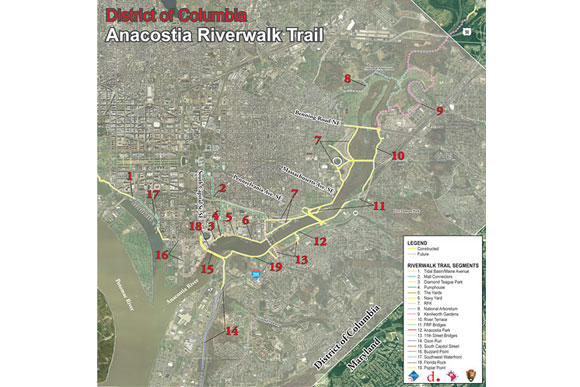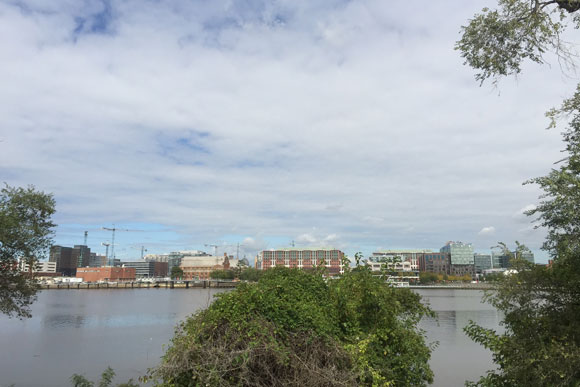Capital Bikeshare and articulated lanes, among other initiatives, have helped make Washington D.C. the
7th most bikable city in the US.
Since many of these improvements benefit commuters most directly, it is easy to forget that D.C. also boasts some world-class opportunities for recreational cycling.
The
Anacostia Riverwalk Trail is an interconnected system of trails stretching 15 miles, with an additional 13 miles in the works that will someday form the nucleus of a revitalized Anacostia waterfront and park. While the beginnings of this transformation are increasingly accessible today, much work remains.
How can I get there?

There are linkages to existing trails along the entire route, but I would recommend starting at either Poplar Point on the east bank or Yards Park on the west. From there, ride northwest along the river as it winds its way through the District. Another option is starting at the northern end of the trail and riding south from River Terrace or RFK Stadium.
The trail is within a half mile of five metro stations: Navy Yard, Potomac Ave, and Stadium Armory on the West Bank as well as Anacostia and Minnesota Ave stations on the East bank. There are also a number of bus routes that stop at numerous points along the trail. Additionally, when the light rail is completed, it will facilitate access from Benning Rd.

Capital Bikeshare is accessible in a number of communities adjacent to the trail, however I was disappointed not to find more stations along the way. There is only one station directly along the Riverwalk, and the density of stations along the East Bank is less frequent than many other parts of the city.
The bikeshare system is neglecting residents of Ward 7 & 8, as well as anyone who wants to explore the Riverwalk but does not personally own a bike, by failing to provide this infrastructure. New stations, placed along the trail could further connect residents to the river and park by providing opportunities for recreation and transport. Optimizing the timing and number of bikes servicing these Riverwalk stations could cut down on any inefficiency caused by differing patterns of use.
What is there to do?
The Anacostia Riverwalk Trail is, at points, a natural oasis removed from the bustle of D.C., while at others it is a reflection of the unrealized potential of the city teeming around it.

Cycling north from Poplar Point, the path winds along the river, offering spectacular views of the Waterfront and Capitol Hill. The restored shoreline is a scenic place for a rest or some birding, depending on the time of year. Because a large section of the East Bank trail cuts through Anacostia Park, it offers convenient access to the amenities including sports fields and playgrounds as well as a swimming pool, boat ramp, and roller skating pavilion.
Anacostia Drive, directly adjacent to the trail, is a quiet surface street, adding to the feeling of seclusion from the rest of the city, but unfortunately, the loud din of traffic on the highway is never far off. Installing sound and visual barriers around sections that border the park would be a low cost, effective way to cut down on such noise.
The immaculately maintained trail then crosses over one of the largest pedestrian overpasses in the district and separates from the river temporarily, before rejoining around River Terrace. At this point the, the East Bank trail comes to a halt, and the Anacostia Riverwalk crosses over the bridge at Benning Road, before turning south along the West Bank.
This northwestern section is sorely lacking in many respects, but potential is not one of them. Acres of parking space stretching toward RFK could make a huge addition to the thin strip of green space encompassing the Riverwalk. Trails should be expanded and new opportunities for recreation planned. This would make a great addition to existing parkland while meeting the needs of community members who are clamoring for a
new vision.
As the Riverwalk continues south, it passes Congressional Cemetery and Navy Yard before working its way toward Yards Park. This final section of the trail, passing neighborhoods that have experienced so much growth and development in recent years, is a tangible example of how cycling and pedestrian infrastructure can become a defining part of a community by reconnecting the city to its forgotten river.
Where do we go from here?

Despite an expansive network of completed trails, the Anacostia Riverwalk is very much a work in progress and will be for years to come. An
extension to the East Bank Trail is due to be completed by 2016 and a recently announced
bikeway along Virginia Ave will connect the Anacostia to Capitol Hill.
The northern addition will extend miles of new trails through Kenilworth Park and Aquatic Gardens, eventually connecting with existing sections further up the river toward Bladensburg. Not only will it allow for longer rides, the extension will connect isolated communities to the river, park and city as never before.
Planners must not only focus on making the trail longer but also improve existing sections through creative new programing. Many cities have experimented with
Health Trails, including workout stations, homeopathic gardens, and educational signs along public trails. Such an initiative along the Anacostia Riverwalk would be a low-cost way to support active lifestyles and expand impact of this unique civic resource.
As it continues to grow, the Anacostia Riverwalk will increasingly define the communities it touches. People with easy access to the river and recreation opportunities will see their physical and mental health improve. New linkages across the river, such as the 11th Street Bridge Park, will take cars off the road, increase economic opportunity, and unite neighborhoods divided from the rest of the city since its origin.
Like most public resources, the active support of community members and volunteers is essential to maintain the Riverwalk and Park. If you are interested in getting involved, the Anacostia Watershed Society holds
monthly cleanups along sections of the trail. The next event is coming up this Sunday, October 18
th, and I encourage all those who haven’t yet attended to get involved.
On beautiful fall weekends, cycling the Anacostia Riverwalk should be at the top every Washingtonians to-do list. However, to meet this increase in demand we need new bikeshare stations, recreation opportunities, and linkages to communities East of the River. So take some time to explore the miles of trails along the Anacostia because the best way to motivate the city to invest in the Riverwalk, is to get out there and use it.
The author is an employee of the Anacostia Waterfront Trust.